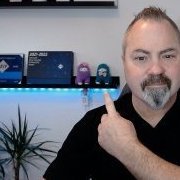-
Posts
9250 -
Joined
-
Last visited
-
Days Won
369
Everything posted by anyweb
-

Help | Few questions & problems regarding SCCM 2012 RC2
anyweb replied to Davidsod's topic in Configuration Manager 2012
if no command prompt opens then you must check your boot image properties (right click on your boot image), look at the Customization tab, is command prompt support enabled in there ? did you update the boot wim images to your dps ? these steps are covered in the guides already if you followed them from Part 1. the new Application model uses Applications in the Software library, the old model (kept for legacy) uses Packages and Programs just like we did in Configuration Manager 2007- 6 replies
-
- Help
- installing applications
- (and 4 more)
-
glad you found it :-)
-

using SCCM 2012 RC in a LAB - Part 8. Deploying Windows 7 X64
anyweb replied to anyweb's topic in Configuration Manager 2012
did you successfully PXE boot before this ? if so just delete the computer object, then re-import it -

Require administrator approval if users request this
anyweb replied to ashridge uk's topic in Configuration Manager 2012
this question was already answered here fyi.- 2 replies
-
- software catalog
- software centre
-
(and 1 more)
Tagged with:
-
that's not the whole screenshot, the deployments tab is listed at the bottom of the screen, do you see that ?
-

Help | Few questions & problems regarding SCCM 2012 RC2
anyweb replied to Davidsod's topic in Configuration Manager 2012
first things first, ConfigMgr 2012 is in release candidate version right now, so i really hope you are not rolling it out in production. on to your questions... 8gb is not too much at all, more ram is always better, here's the supported hardware list from Microsoft on Technet - http://technet.microsoft.com/en-us/library/gg682077.aspx#BKMK_SupConfigSiteSystemReq Configmgr 2012 now has Active Directory Forest Discovery - read about it here - http://technet.microsoft.com/en-us/library/gg712308.aspx#BKMK_ADForestDisc tly do i need to do and configure in order to integrate the WSUS & the SCCM server? is it recommanded? where can i find information about it? ConfigMgr relies on WSUS to synchronise and download updates from Microsoft, - Software Updates in configmgr are described here on technet - http://technet.microsoft.com/en-us/library/gg682068.aspx error code 0x00000032 means unsupported meaning you tried to do something that you are not allowed to do, like capture while in windows when you should be in windows PE the smsts.log file will reveal what package is missing, you need to update that package to the dp's and then try again. you still have the legacy package/program model in ConfigMgr 2012 for just this purpose.- 6 replies
-
- Help
- installing applications
- (and 4 more)
-
have you tried installing it at all ? did you get any errors ?
-

Setting computername during deployment
anyweb replied to anyweb's question in Troubleshooting, Tools, Hints and Tips
only thing to note is if you are using MDT integration to add scripts etc, then you'll need to use MDT 2012 Rc1 (currently) -
same place, click on the deployments tab when you've selected your package, does it say 'no items found' or what ? show me a screenshot
-
you are looking in the wrong place for example if it's a deployment for an Application, go into software library, locate the app itself and click on the deployments tab, you can then select your Deployment and right click, delete
-
nothing has been said, so we are all in the dark, just like you
-
i've alerted the DOCS team and they will change the wording to spell this out clearly during the next scheduled Documentation Update
- 13 replies
-
- software centre
- applications
-
(and 1 more)
Tagged with:
-
well it's not that obvious and I just checked the Docs, they state which still doesn't reveal that you must Deploy to a User collection in order for this option to be valid, however the actual option "Require administrator approval if users request this application" does mention users specifically and not Systems/Devices so hopefully that clears it up cheers niall
- 13 replies
-
- software centre
- applications
-
(and 1 more)
Tagged with:
-
correct, you must deploy it to a User collection try it and see
- 13 replies
-
- software centre
- applications
-
(and 1 more)
Tagged with:
-
what collection is it Deployed to ?
- 13 replies
-
- software centre
- applications
-
(and 1 more)
Tagged with:
-
show me a screenshot of what you are seeing
- 13 replies
-
- software centre
- applications
-
(and 1 more)
Tagged with:
-

How to spread the load of software updates with sccm 2012?
anyweb replied to bartb's topic in Configuration Manager 2012
well to spread the load, put your virtual machines on different SANS to increase your IOPS -
smsts.log file should reveal the issue (on the client you are trying to capture)



